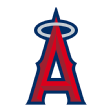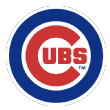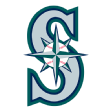Another milestone in baseball's offseason passed Thursday afternoon as baseball's winter meetings concluded. While it wasn't the most action-packed winter meetings, with only one of Keith Law's top 20 free agents signed, there were a few big trades and some of the non-closer relief free agents started inking deals.
As we pass through the middle of December, baseball's offseason is now almost halfway over (it hits the exact 50 percent point next week). While there's a lot of time remaining, it's a good opportunity to revise our Way-Too-Early 2018 projections and see which teams have gained and lost the most playoff probability so far.
It may be halftime, but they still show the score at halftime, don't they?
The offseason winners
 Los Angeles Angels: +32.3%
Los Angeles Angels: +32.3%
This one came down to the wire, with the late-week acquisition of second baseman Ian Kinsler just edging the Angels ahead of the No. 2 team in these rankings. What's encouraging for Angels fans is how aggressive the team is finally being at its quest to not waste Mike Trout's prime. The Angels aren't upgrading from average players, they're filling real holes on the roster.
We've talked a lot about the acquisition of Shohei Ohtani and make no mistake about it, he's good. But it's easy to underrate just how much of a short-term improvement Kinsler represents. Even in an obvious down year, he still hit for enough power (22 homers) and played well enough defensively to end up with 2.1 WAR (baseball-reference). Now, that's not the five-plus he's been at each of the past four years, but he still scratched out a league-average season.
Almost the entirety of Kinsler's drop in offense was from batting average, having lost 52 points of batting average from 2016 and 106 points in OPS (batting average essentially counts double in OPS as a key part of both OBP and SLG). Much of that was a 70-point drop in BABIP to .244, 42 points below his career average. ZiPS uses hit velocity and location data to model BABIP and believes that Kinsler "should have" had a .310 BABIP. And Kinsler doesn't have a history of underperforming this model, coming in at .317 and .311 the previous two seasons compared to his actual .314 and .323 BABIP.
ZiPS does not see Kinsler bouncing back to 2016 levels. He turns 36 next year and that's a big deal. But ZiPS sees him getting enough back to get up to a 101 OPS+ and be a three-win player for the Angels.
 St. Louis Cardinals: +20.3%
St. Louis Cardinals: +20.3%
The Cardinals were rightly disappointed in not being able to acquire Giancarlo Stanton from the Marlins, but in this case I think I prefer the consolation prize. Not that Stanton isn't a better hitter than Marcell Ozuna, but the Cardinals didn't need to add a $300 million debt to their books and they brought in Ozuna without losing either of their top two pitching prospects, Luke Weaver and Jack Flaherty.
Ozuna is an obvious improvement, a true power bat for a team that was one of the rare teams that actually lost significant homers from 2016 to 2017. And the Cardinals have done more just adding Ozuna since the offseason began, such as the lower key signings of Miles Mikolas and Luke Gregerson who both fill crucial depth needs for the team. They're still trying to sell the Jays on letting Josh Donaldson go, but no credit for deals not made yet!
 Chicago Cubs: +8.2%
Chicago Cubs: +8.2%
Brandon Morrow is not better than Wade Davis, but my initial projections didn't include unsigned free agents as part of the roster. And while Morrow won't quite match Davis, he took to relief work better than anyone could have anticipated, and the Cubs made other depth signings in Steve Cishek and added another arm in Tyler Chatwood. No, these aren't big signings, but the Cubs are better than they were a month ago.
 New York Yankees: +7.9%
New York Yankees: +7.9%
Why so low? In this case, ZiPS already projected the Yankees as having an 86 percent chance of making the playoffs in 2018 based on current rosters, so there was only so far for them to improve. Stanton is, of course, a gigantic addition to the outfield. The Yankees do give a little back though with the salary dump of Chase Headley, who while underperforming in New York, was at least a plausible starter and better than their current on-roster options. Starlin Castro is a better player than Headley, but more likely to be replaced by Gleyber Torres at some point this season.
 Seattle Mariners: +6.1%
Seattle Mariners: +6.1%
They still need to add pitching, but acquiring Dee Gordon to play center field gives them the replacement to Jarrod Dyson they didn't really have available in-house. ZiPS also gives a big thumbs-up to relief addition Juan Nicasio with a projection of a 3.44 ERA with 77 strikeouts in 68 innings. He's a valuable bullpen workhorse for the Mariners.
There's still a lot more work to be done -- while all the teams above the Mariners on this list have better than coin-flip odds, the Mariners still are closer to dice odds. But the team's not off to a bad start!
The offseason losers
 Miami Marlins: -23.4%
Miami Marlins: -23.4%
Oh come on, did you not think this was going to be the Marlins? While the long-term outlook of the Marlins is still up for debate, they haven't really gotten an immense haul for two-thirds of the team's outfield and if they're not trading Christian Yelich for some odd reason, it's not like they're going to get as good a prospect for Dan Straily as they gave up for him.
There remains a sliver of a playoff shot, but 23.4% is almost the entirety of their playoff odds. I'm certainly not banking on it, but the future is foggy and baseball can be weird sometimes.
The Rest of the American League East:
Boston Red Sox: -10.3%
Toronto Blue Jays: -8.7%
Baltimore Orioles: -7.9%
Tampa Bay Rays: -7.6%
The rest of the AL East comes in neat order here because when push comes to shove, nobody in the divisions except for New York has done much to improve its roster yet. It's not just the Yankees hurting the AL East teams either: As the Angels' wild-card odds increase, it also takes some of that avenue to the playoffs away from other AL wild-card contenders.
I don't expect the Red Sox at least to finish the offseason at this spot considering their money, willingness to spend and all the free-agent targets that are still out there. But they rank here right now.
 Milwaukee Brewers: -6.5%
Milwaukee Brewers: -6.5%
Like the teams in the AL East, the Brewers' odds drop by virtue of losing ground to the top divisional contenders. Unlike earlier in the rebuild, the Brewers are willing to spend some money, already being in on Anthony Swarzak but not wanting to pay him as much as the Mets did. ZIPS currently projects the Brewers' rotation at 11th in the NL in 2018 WAR, due to a combination of regression and Jimmy Nelson's injury concerns. Adding a starter at the top of the rotation should still be a team priority.
Honorable mention
 San Francisco Giants: -1.4%
San Francisco Giants: -1.4%
The Giants haven't lost that much ground with the NL West generally being quiet outside of Chris Iannetta signing with the Rockies (which does help considering Colorado has little MLB talent behind the plate).
What makes the Giants' offseason especially depressing is how close they were to both Stanton and Ohtani and how they've come away with neither one. And, really, nothing else so far. And the Giants are in a position where they really have to add a lot to be relevant, in the neighborhood of 10 wins to be anything but a long shot. To illustrate this, here's a list of how the playoff probabilities change based on the scenarios that could have happened, compared to the depressing reality.
Giants acquire Stanton, Ohtani, one of Ozuna/Yelich, ... And Clayton Kershaw quits the sport: +59.7%
Giants acquire Stanton, Ohtani and one of Ozuna/Yelich: +53.5%
Giants acquire Stanton and Ohtani: +30.5%
Giants acquire Ohtani and one of Ozuna/Yelich: +25.1%
Giants acquire Stanton: +20.3%
Giants acquire Yelich: +8.0%
Giants acquire Ozuna: +7.2%
Actual: -1.4%
